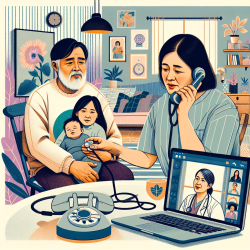Introduction
In the realm of speech-language pathology and online therapy services, understanding the context in which interventions are implemented is crucial for achieving successful outcomes. The research article "Understanding Contexts: How Explanatory Theories Can Help" provides valuable insights into the importance of context in healthcare systems and how explanatory theories can be applied to improve interventions. This blog will explore how practitioners can leverage these insights to enhance their skills and create better outcomes for children in therapy.
The Role of Explanatory Theories
Explanatory theories are multi-variable constructs that help make sense of complex events and situations. They are particularly valuable in understanding the dynamic and complex environments of healthcare systems, which are among the most intricate human environments. By using explanatory theories, practitioners can align their interventions with the host systems, leading to more effective and sustained changes.
Applying Explanatory Theories in Practice
For practitioners in speech-language pathology, applying explanatory theories involves several key steps:
- Create an Explanatory Theory: Early in the planning of an intervention, develop an explanatory theory of the local environment. This theory should incorporate basic explanatory principles, such as unifying the components of the environment into a coherent model.
- Use Established Theories: Leverage mature explanatory theories, such as the FITT framework (Fit between Individuals, Tasks, and Technologies), to understand the interaction between individuals and the technologies used in therapy.
- Adapt and Revise: As more is learned about the local environment and the interaction between the intervention and the environment, practitioners should be open to revising their explanatory theories to better fit the context.
Benefits for Child Outcomes
By incorporating explanatory theories into their practice, speech-language pathologists can enhance their understanding of the contexts in which they work. This deeper understanding can lead to more tailored interventions that are better suited to the unique needs of each child. As a result, children are more likely to experience positive outcomes, such as improved communication skills and greater engagement in therapy.
Encouraging Further Research
While the insights from "Understanding Contexts: How Explanatory Theories Can Help" are invaluable, practitioners are encouraged to conduct further research and explore additional explanatory theories that may be applicable to their specific practice settings. By staying informed and continuously seeking new knowledge, practitioners can remain at the forefront of their field and provide the highest quality care to their clients.
To read the original research paper, please follow this link: Understanding contexts: how explanatory theories can help.










